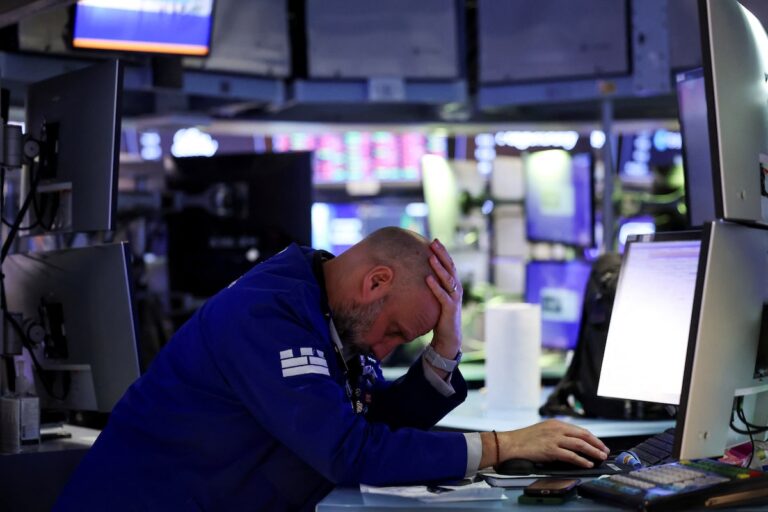The pain was “ten out of ten,” according to Takeuchi Shuntaro.
But he wasn’t describing the performance of the portfolio of Japanese stocks he manages from San Francisco, California—he was talking about his appendix.
It had to come out, just as a colleague from Matthews Asia called to discuss navigating the turmoil engulfing their $7 billion asset management business.
“I was on a conference call two minutes before surgery,” Takeuchi said. “The nurse asked me, ‘Do you really have to attend this?’”
Meanwhile, in Tokyo, the Nikkei was plunging towards a 4% loss by Wednesday, with trillions of dollars wiped off global stocks—the largest dollar-value drawdown on record.
The ten trading days since U.S. President Donald Trump imposed new tariffs on carmakers have been the most volatile since the pandemic panic of 2020. Bonds, oil, gold, and even the U.S. dollar itself have been violently shaking.
U.S. Treasury bonds, traditionally a safe haven and a linchpin of global markets, experienced their heaviest selling pressure in decades, underscoring the profound anxiety gripping financial and trade networks worldwide.
The turmoil began on what Trump dubbed “Liberation Day,” April 2nd, when he erected the highest tariff barriers around the U.S. economy seen in a century.
In the following weeks, the situation escalated into an open economic conflict with China. By Friday, tariffs had surged to 145%, effectively creating a U.S. trade embargo.
Since April 2nd, more than $5 trillion has vanished from the MSCI Global Stocks Index, reflecting investor unpreparedness for Trump’s aggressive tariff policies. Market swings exposed vulnerabilities tied to Trump’s unpredictability, raising concerns about lasting damage to America’s pivotal role in global finance.
“We’ve built up confidence, but we don’t yet know the secondary impacts on the market,” said Geoff Wilson, a veteran fund manager in Australia. “Some hedge funds may have already collapsed. There could be further consequences, which we’ll only discover in the coming weeks.” His fund, notably, has been actively buying amid the disruptions.
Grave Cleaning
Initially, selling centered around companies tied closely to economic growth—banks, industrial metals, and firms like Apple with supply chains heavily dependent on China.
Then on April 4th, during China’s Tomb-Sweeping holiday—a day traditionally devoted to honoring ancestors—Beijing retaliated by imposing a 34% tariff on imports from the U.S.
Oil dropped to its lowest level in four years, while major global stock indices breached thresholds market experts refer to as a “correction”—a decline of more than 10% from recent peaks.
Even gold, usually seen as a safe haven in turbulent times, began falling. Investors, forced to cover margin calls, sold off some of their safest assets, magnifying market anxiety.
For Wong Kok Hoi, founder and CEO of APS Asset Management in Singapore, this was a scenario he’d feared for years—though not quite at this scale.
“In my worst dreams, I didn’t imagine tariffs would reach 125%,” he admitted. “At that point, trade between the world’s two biggest economies effectively halts.”
Yet for Wong, conveniently positioned in China’s semiconductor, artificial intelligence, and biotech sectors, his portfolio still rose approximately 20%.
Trade Wars
On Wall Street, bankers held global conference calls in attempts to calm rattled investors.
Over the weekend, markets had clung to hopes that Trump might soften his stance. But asked by reporters on Air Force One after a golf weekend about Sunday’s plunging markets, Trump quipped, “Sometimes you just have to take your medicine.”
That comment unleashed further panic. Nasdaq 100 futures quickly fell more than 5%, and Nikkei futures triggered circuit breakers after diving 8%, continuing their descent afterward.
Wall Street’s CBOE Volatility Index (the VIX), nicknamed the “Fear Gauge,” soared above 60—a threshold typically only breached during severe crises like 2008 and 2020.
The S&P 500 closed 17% below the record highs achieved just seven weeks earlier. Christopher Forbes, Asia Head at CMC Markets, noted that Friday and Monday saw the highest trading volumes on record.
Back in California, Takeuchi attempted to shield his portfolio from the chaos, surgery notwithstanding.
“We actively traded,” he explained, adding that his team bought and sold whenever their portfolio companies or watchlist stocks hit target or attractive price levels. They favored companies with limited U.S. exposure, cautious not to make outsized bets on either side of the trade conflict.
“I don’t want to be overly dramatic,” Takeuchi said. “We’re not panicking. Our goal is risk management and careful stock selection.”
Bond Fire
For months, the currency market, as a vital tool of global trade, had been expected to lead any tariff-driven adjustments.
Instead, shock came from the bond market. Shortly after tariffs officially took effect, Asia saw massive waves of U.S. Treasury bond selling.
Typically liquid and stable, the U.S. Treasury market swung wildly. This volatility marked the most severe stage yet in the market’s “tariff tantrum.”
Yields on the benchmark 10-year Treasury surged nearly 20 basis points—a clear indication that traders urgently needed liquidity, or, more worryingly, that bonds were losing their status as safe-haven assets.
Within hours, however, sentiment flipped again. Trump shocked markets once more by announcing a temporary bilateral tariff suspension, easing taxes briefly before reinstating them at higher levels.
Stocks surged sharply, posting some of the largest single-day percentage gains since 2008, but uncertainty quickly dragged markets back into volatility.
Whiplash
Martin Wetton, head of financial market strategy at Westpac and a 30-year market veteran, described Wednesday’s bond market activity as unprecedented.
“Usually, in times of crisis, investors scramble to buy dollars for safety—but this didn’t happen this time. It’s alarming and deeply unusual,” he said.
By Friday—just 11 trading sessions since Trump first announced tariffs on automakers—it appeared the dust might settle. However, Beijing promptly raised tariffs on U.S. imports to 125%, reigniting the volatility.
Stocks tumbled again, while the dollar weakened dramatically against safe-haven currencies like the Swiss franc. Conversations shifted to broader implications: was this the beginning of the end of U.S. financial hegemony?
“It’s as though we’ve compressed a full year’s volatility into a matter of days,” said Jack McIntyre, portfolio manager at Brandywine Global in the U.S.
“For now, you focus on what you can understand,” he said, referring to anticipated slowdowns in the U.S. economy and potentially further dollar depreciation as global investors shed U.S. assets.




